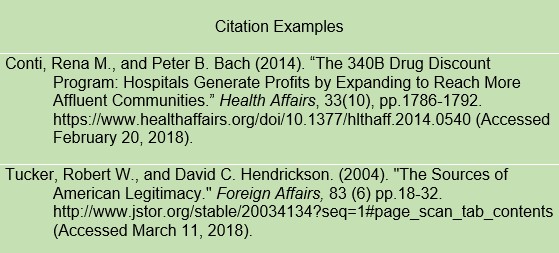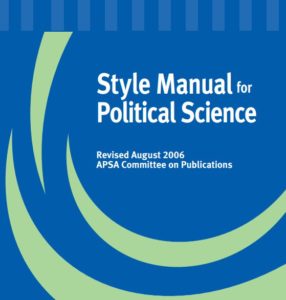Much to my surprise, as a Political Science major, I have never had to cite sources in the American Political Science Association (APSA) format. Thus far, my political science professors have not had any preferences for citations styles. They only care that students are consistent with the citation style they choose and that they cite sources properly. When I cite sources in my papers, I usually default to using MLA because I’ve been familiar with this style since sixth grade. For my own educational development, and in the event a classmate or myself ponders submitting a paper for publication in the American Political Science Review Journal, I thought it would be beneficial to learn about this citation style.
What is APSA?
APSA is a citation style that is commonly used by political scientists for manuscript publication in the American Political Science Review Journal. It is largely derived from the Chicago Manual of Style citation format.
Basic Formatting Guidelines for Manuscript Submissions
- A title page with an abstract
- Text
- Appendix, if necessary
- Notes, if necessary (for submission and review purposes, authors are encouraged to use footnotes; manuscripts accepted for publication must be submitted with endnotes)
- References
- Titled and numbered tables, each on a separate page
- Titled and numbered figures, each on a separate page
*All parts should be double-spaced and include sequential page numbering *
Source: APSA style guide
Formatting In-text Citations
An in-text citation requires the last name of the author(s) and the year of publication. There is no comma between the author’s last name and publication year.
- Example: (Fukuyama 1980).
When you are citing a work that includes two or three author names, you must include each name in your in-text citation and the publication year.
- Example: (Johnston, Cooper, and Warner 1997).
When you are citing a work that includes 4 or more author names, you must include the first author’s name, et al., and the publication year.
- Example: (Miller et al. 2002).
Formatting Citations in a Reference Section
Electronic Journals
When you are citing electronic journal articles, include the following information: Author’s last name, Author’s first name. Publication year. “Title of the article.” Title of the journal, volume number (issue number), page number. URL (Accessed Month Day, Year).
*For some articles, you may not be given all of these elements. In this case, provide as much information as possible.

Books
When you are citing books, include the following information:
Author’s last name, Author’s first name. Publication Year. Title of book. Place of publication: Name of publisher.
*If the city of publication is well-known, the state of publication is not necessary.
Governmental and Legal Documents
Hearings
To write citations for congressional hearings, include the following information:
U.S. Congress, Chamber of Congress, name of committee. Year hearing was held. Name of the hearing. Meeting of Congress, Congressional session, Date Month of hearing.
Statutes
When you are citing statutes, include the following information:
Name of statute. Year statute was created. Source of statute. Volume number, section number.
Court Cases
When you are citing court cases, adhere to the following format:
Court case name. Year. Volume Source Page court case begins.
I hope this quick guide helps you if you ever have to cite sources in the APSA citation format. If you need additional help or clarification, please refer to the APSA style manual.







